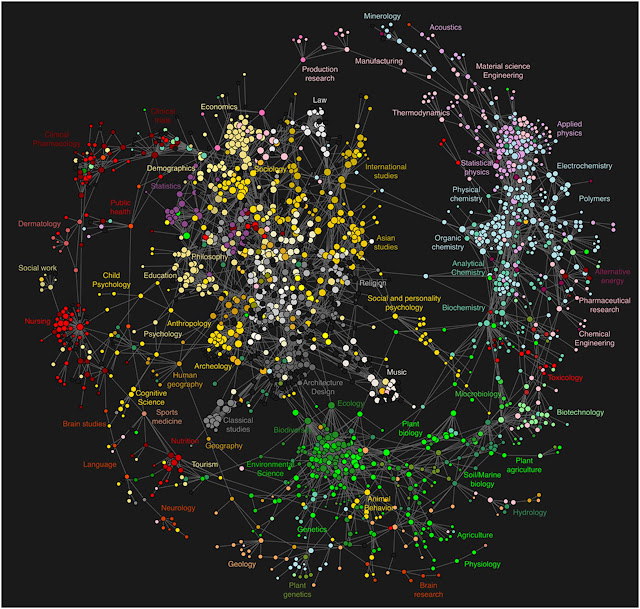A fascination visualization from a
scholarly article that uses clickstream data, rather than citations, to look at links among the various disciplines. What is interesting to me about this mapping is not the connections, but the gaps. The gaps are a guide to potentially innovative collaborations across disciplines. For example, could applied physics have anything to teach a researcher of public health? Could an economist have a fruitful collaboration with a classicist?
Background
Intricate maps of science have been created from citation data to visualize the structure of scientific activity. However, most scientific publications are now accessed online. Scholarly web portals record detailed log data at a scale that exceeds the number of all existing citations combined. Such log data is recorded immediately upon publication and keeps track of the sequences of user requests (clickstreams) that are issued by a variety of users across many different domains. Given these advantages of log datasets over citation data, we investigate whether they can produce high-resolution, more current maps of science.
Methodology
Over the course of 2007 and 2008, we collected nearly 1 billion user interactions recorded by the scholarly web portals of some of the most significant publishers, aggregators and institutional consortia. The resulting reference data set covers a significant part of world-wide use of scholarly web portals in 2006, and provides a balanced coverage of the humanities, social sciences, and natural sciences. A journal clickstream model, i.e. a first-order Markov chain, was extracted from the sequences of user interactions in the logs. The clickstream model was validated by comparing it to the Getty Research Institute's Architecture and Art Thesaurus. The resulting model was visualized as a journal network that outlines the relationships between various scientific domains and clarifies the connection of the social sciences and humanities to the natural sciences.
Conclusions
Maps of science resulting from large-scale clickstream data provide a detailed, contemporary view of scientific activity and correct the underrepresentation of the social sciences and humanities that is commonly found in citation data.






No comments:
Post a Comment
Note: Only a member of this blog may post a comment.